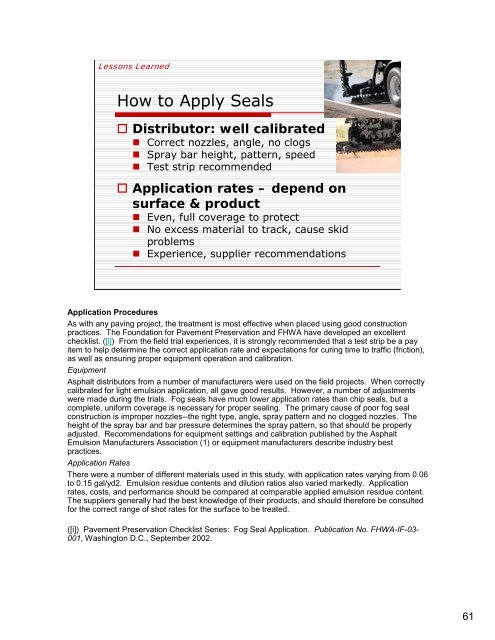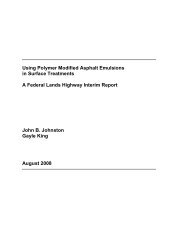Spray Applied Polymer Surface Seals - TSP2
Spray Applied Polymer Surface Seals - TSP2
Spray Applied Polymer Surface Seals - TSP2
You also want an ePaper? Increase the reach of your titles
YUMPU automatically turns print PDFs into web optimized ePapers that Google loves.
Lessons Learned<br />
How to Apply <strong>Seals</strong><br />
Distributor: well calibrated<br />
• Correct nozzles, angle, no clogs<br />
• <strong>Spray</strong> bar height, pattern, speed<br />
• Test strip recommended<br />
Application rates – depend on<br />
surface & product<br />
• Even, full coverage to protect<br />
• No excess material to track, cause skid<br />
problems<br />
• Experience, supplier recommendations<br />
Application Procedures<br />
As with any paving project, the treatment is most effective when placed using good construction<br />
practices. The Foundation for Pavement Preservation and FHWA have developed an excellent<br />
checklist. ([i]) From the field trial experiences, it is strongly recommended that a test strip be a pay<br />
item to help determine the correct application rate and expectations for curing time to traffic (friction),<br />
as well as ensuring proper equipment operation and calibration.<br />
Equipment<br />
Asphalt distributors from a number of manufacturers were used on the field projects. When correctly<br />
calibrated for light emulsion application, all gave good results. However, a number of adjustments<br />
were made during the trials. Fog seals have much lower application rates than chip seals, but a<br />
complete, uniform coverage is necessary for proper sealing. The primary cause of poor fog seal<br />
construction is improper nozzles--the right type, angle, spray pattern and no clogged nozzles. The<br />
height of the spray bar and bar pressure determines the spray pattern, so that should be properly<br />
adjusted. Recommendations for equipment settings and calibration published by the Asphalt<br />
Emulsion Manufacturers Association (1) or equipment manufacturers describe industry best<br />
practices.<br />
Application Rates<br />
There were a number of different materials used in this study, with application rates varying from 0.06<br />
to 0.15 gal/yd2. Emulsion residue contents and dilution ratios also varied markedly. Application<br />
rates, costs, and performance should be compared at comparable applied emulsion residue content.<br />
The suppliers generally had the best knowledge of their products, and should therefore be consulted<br />
for the correct range of shot rates for the surface to be treated.<br />
([i]) Pavement Preservation Checklist Series: Fog Seal Application. Publication No. FHWA-IF-03-<br />
001, Washington D.C., September 2002.<br />
61
















